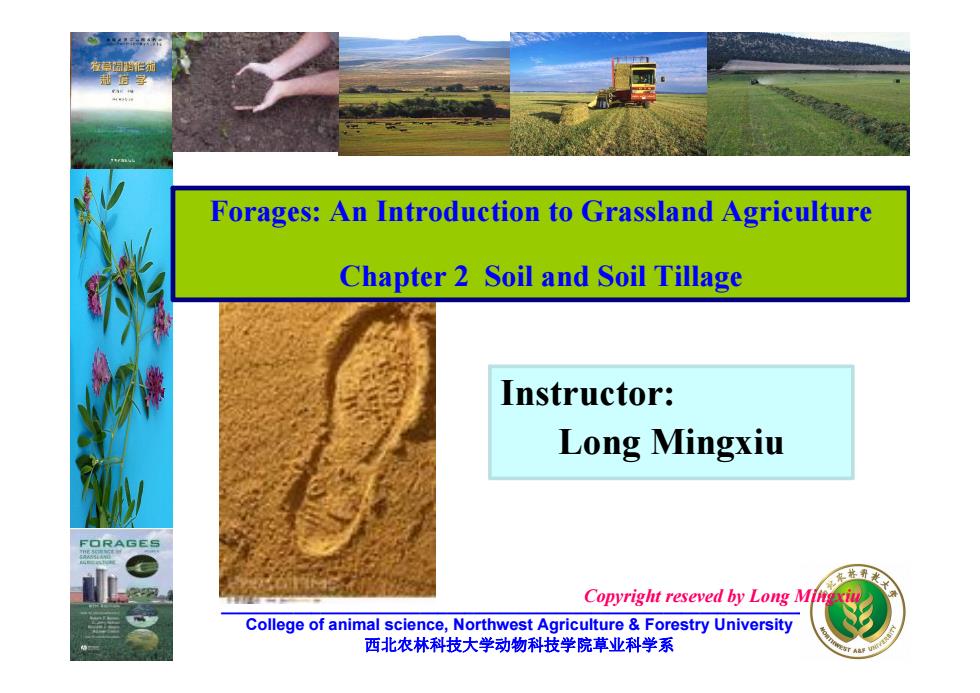
Forages:An Introduction to Grassland Agriculture Chapter 2 Soil and Soil Tillage Instructor: Long Mingxiu F■RAG Copyright reseved by Long M College of animal science,Northwest Agriculture Forestry University 西北农林科技大学动物科技学院草业科学系
__________________________________________________________________ College of animal science, Northwest Agriculture & Forestry University 西北农林科技大学动物科技学院草业科学系 Copyright reseved by Long Mingxiu Forages: An Introduction to Grassland Agriculture Chapter 2 Soil and Soil Tillage Instructor: Long Mingxiu

Overview of Chapter 2 On completion this chapter you should learn: 1.Concepts: soil,soil fertility,soil texture,soil structure, soil tillage,mixed cropping,interplanting, multiple cropping 2.Soil type and the characters of soil texture and tillage measure. 3.What kind of soil structure is the most ideal ■RA日 in agriculture?why? Copyright reseved by Long Mig College of animal science,Northwest Agriculture Forestry University 西北农林科技大学动物科技学院草业科学系
__________________________________________________________________ College of animal science, Northwest Agriculture & Forestry University 西北农林科技大学动物科技学院草业科学系 Copyright reseved by Long Mingxiu On completion this chapter you should learn: 1. Concepts: soil, soil fertility, soil texture, soil structure, soil tillage, mixed cropping, interplanting, multiple cropping 2. Soil type and the characters of soil texture and tillage measure. 3.What kind of soil structure is the most ideal in agriculture? why? Overview of Chapter 2
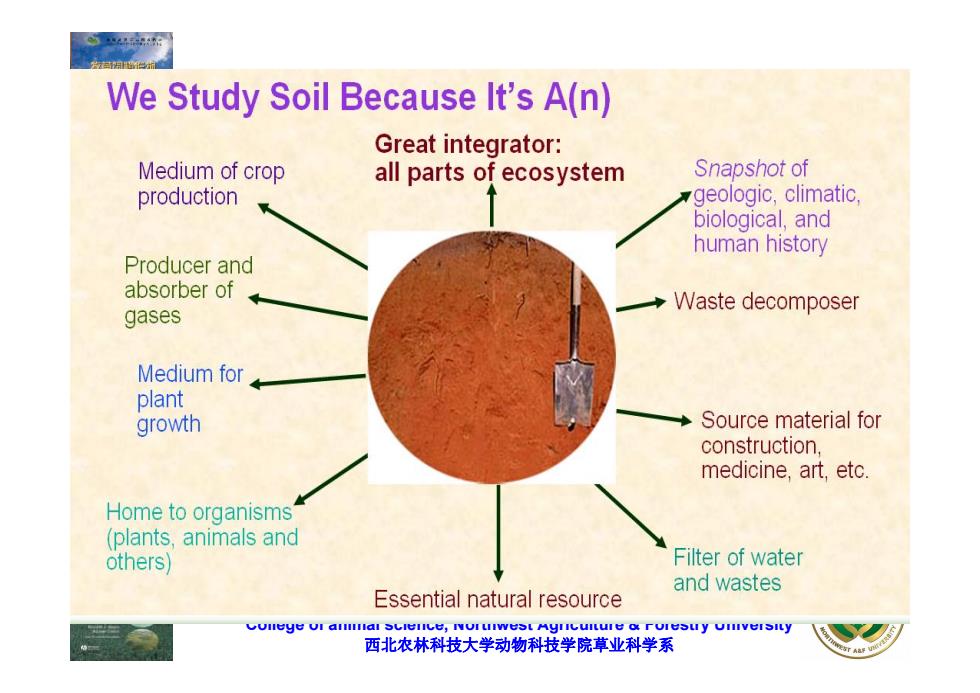
We Study Soil Because It's A(n) Great integrator: Medium of crop all parts of ecosystem Snapshot of production geologic,climatic biological,and human history Producer and absorber of Waste decomposer gases Medium for plant growth Source material for construction, medicine,art,etc. Home to organisms (plants,animals and others) Filter of water and wastes Essential natural resource Colleye ol allllal sclelce,NoruIwest Aylcullule rolesuy Ulllveislly 西北农林科技大学动物科技学院草业科学系
__________________________________________________________________ College of animal science, Northwest Agriculture & Forestry University 西北农林科技大学动物科技学院草业科学系 Copyright reseved by Long Mingxiu
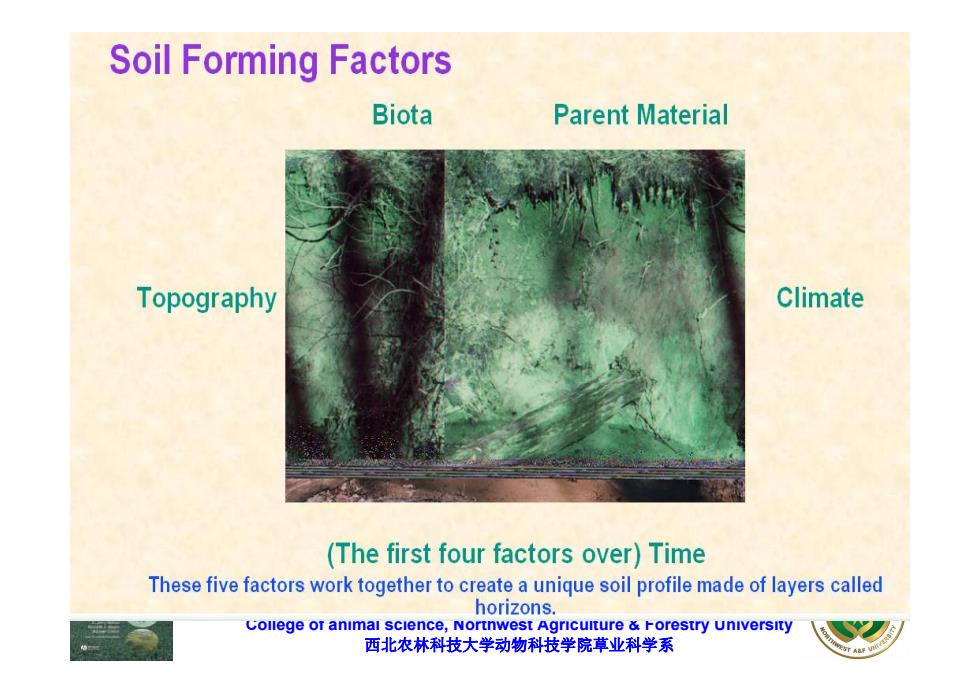
Soil Forming Factors Biota Parent Material Topography Climate (The first four factors over)Time These five factors work together to create a unique soil profile made of layers called horizons. College or animal science,Nortnwest Agricuiture Forestry university 西北农林科技大学动物科技学院草业科学系
__________________________________________________________________ College of animal science, Northwest Agriculture & Forestry University 西北农林科技大学动物科技学院草业科学系 Copyright reseved by Long Mingxiu
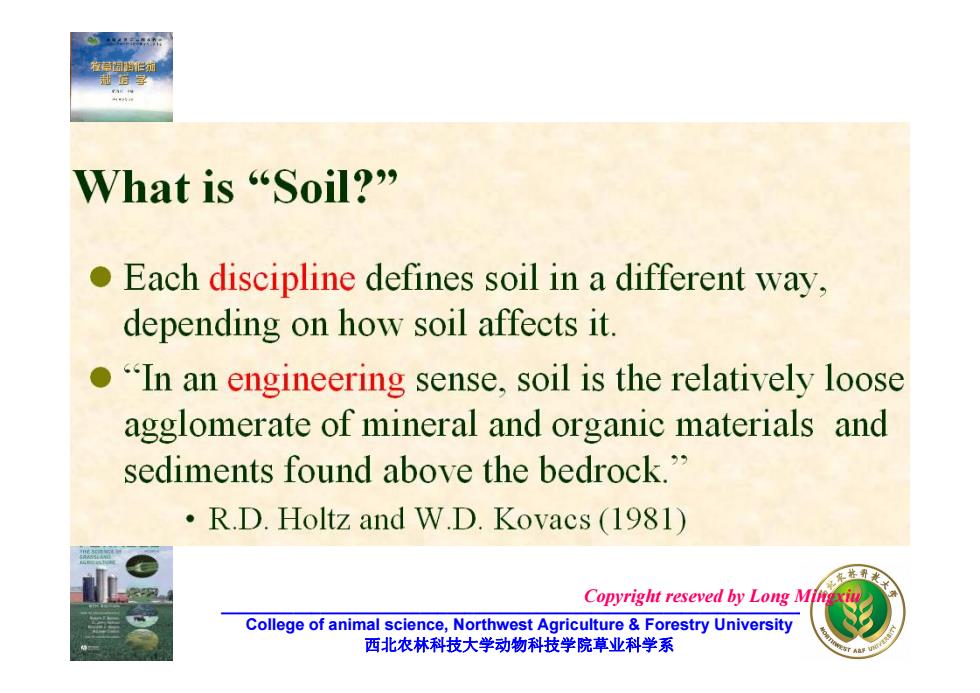
What is“Soil? Each discipline defines soil in a different way, depending on how soil affects it. In an engineering sense,soil is the relatively loose agglomerate of mineral and organic materials and sediments found above the bedrock." R.D.Holtz and W.D.Kovacs (1981) Copyright reseved by Long Miitg College of animal science,Northwest Agriculture Forestry University 西北农林科技大学动物科技学院草业科学系
__________________________________________________________________ College of animal science, Northwest Agriculture & Forestry University 西北农林科技大学动物科技学院草业科学系 Copyright reseved by Long Mingxiu

Phvsical ●Nutrient Characteristics Characteristics (Soil Soil Texture, Chemistry) Consistency, Chemical bonding Structure opH Soil Compaction Cation Exchange (Bulk Density) Capacity (CEC) OSoil Moisture O Nutrient availability
__________________________________________________________________ College of animal science, Northwest Agriculture & Forestry University 西北农林科技大学动物科技学院草业科学系 Copyright reseved by Long Mingxiu
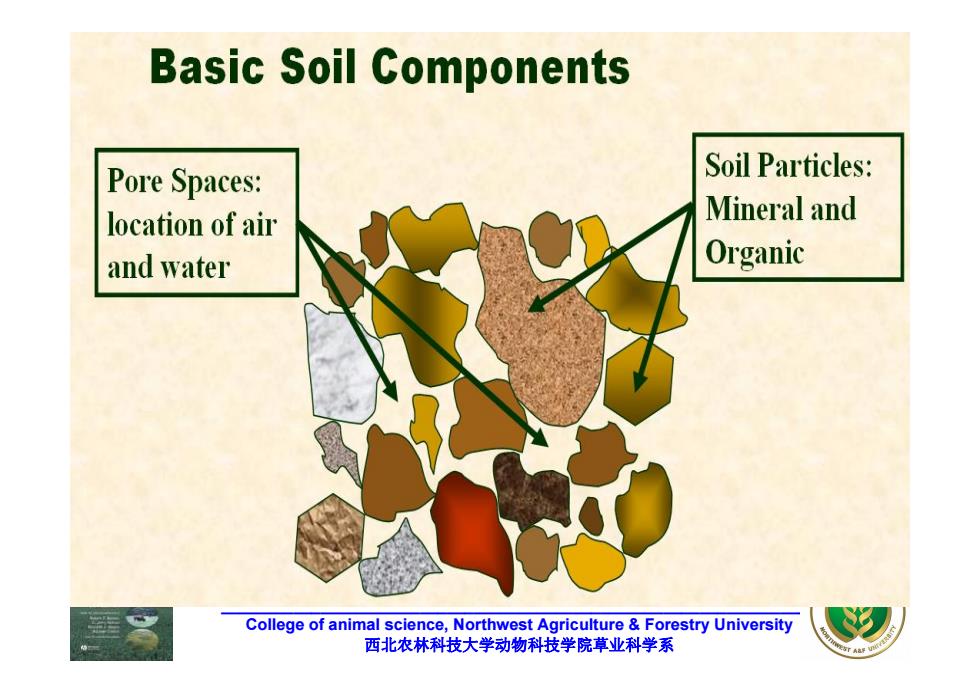
Basic Soil Components Pore Spaces: Soil Particles: location of air Mineral and and water Organic College of animal science,Northwest Agriculture&Forestry University 西北农林科技大学动物科技学院草业科学系
__________________________________________________________________ College of animal science, Northwest Agriculture & Forestry University 西北农林科技大学动物科技学院草业科学系 Copyright reseved by Long Mingxiu
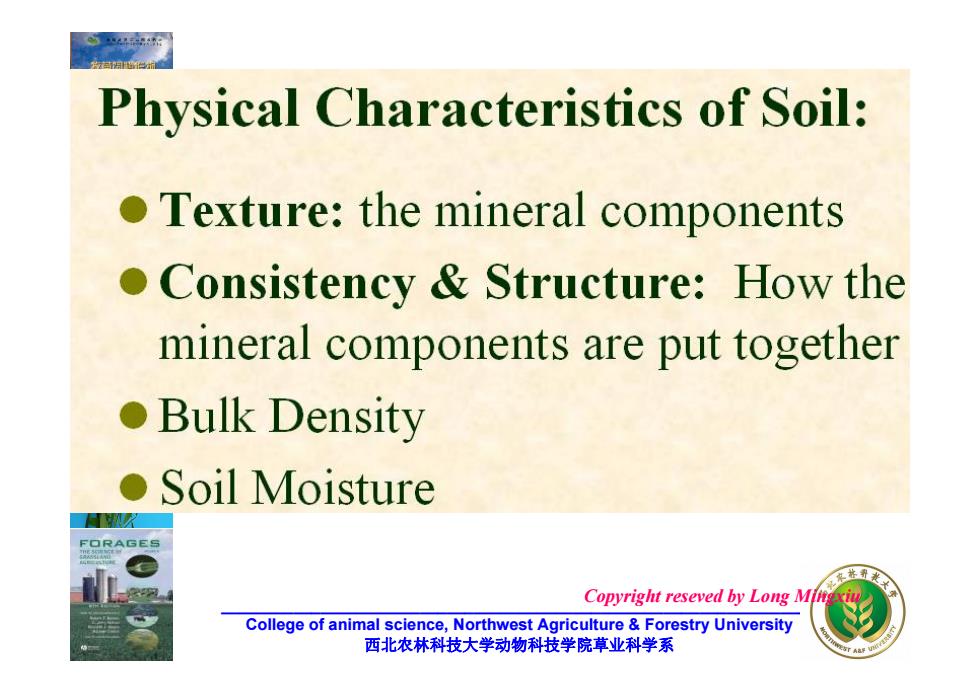
Physical Characteristics of Soil: Texture:the mineral components Consistency Structure:How the mineral components are put together ●Bulk Density ●Soil Moisture F■▣RAGES Copyright reseved by Long M College of animal science,Northwest Agriculture Forestry University 西北农林科技大学动物科技学院草业科学系
__________________________________________________________________ College of animal science, Northwest Agriculture & Forestry University 西北农林科技大学动物科技学院草业科学系 Copyright reseved by Long Mingxiu
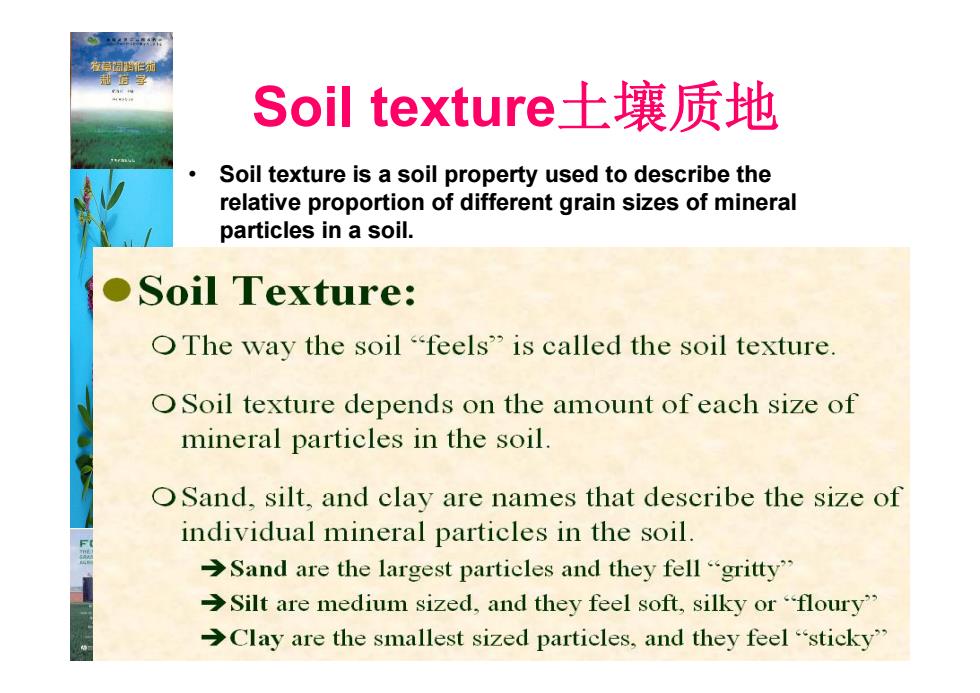
Soil texture土壤质地 ● Soil texture is a soil property used to describe the relative proportion of different grain sizes of mineral particles in a soil. ●Soil Texture: OThe way the soil"feels"is called the soil texture. OSoil texture depends on the amount of each size of mineral particles in the soil. OSand,silt,and clay are names that describe the size of individual mineral particles in the soil. ■ Sand are the largest particles and they fell"gritty" Silt are medium sized,and they feel soft,silky or"floury" Clay are the smallest sized particles,and they feel"sticky
__________________________________________________________________ College of animal science, Northwest Agriculture & Forestry University 西北农林科技大学动物科技学院草业科学系 Copyright reseved by Long Mingxiu Soil texture土壤质地 • Soil texture is a soil property used to describe the relative proportion of different grain sizes of mineral particles in a soil
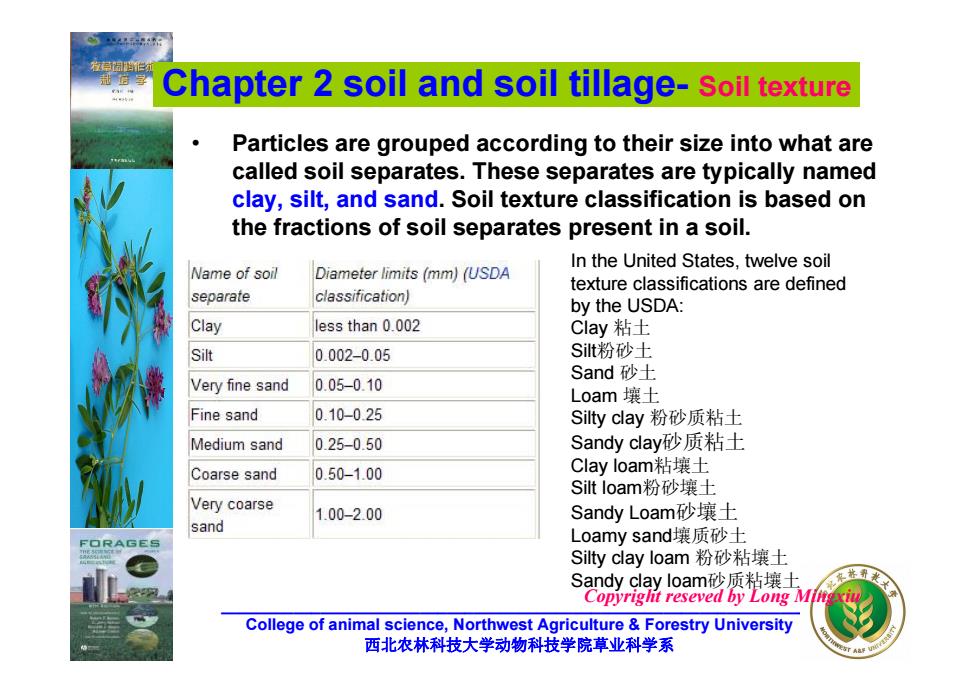
Chapter 2 soil and soil tillage-soil texture Particles are grouped according to their size into what are called soil separates.These separates are typically named clay,silt,and sand.Soil texture classification is based on the fractions of soil separates present in a soil. Name of soil Diameter limits(mm)(USDA In the United States,twelve soil texture classifications are defined separate classification) by the USDA: Clay less than 0.002 Clay粘土 Silt 0.002-0.05 Sit粉砂土 Very fine sand 0.05-0.10 Sand砂土 Loam壤土 Fine sand 0.10-0.25 Silty clay粉砂质粘土 Medium sand 0.25-0.50 Sandy clay砂质粘土 Coarse sand 0.50-1.00 Clay loam粘壤土 Silt loam粉砂壤土 Very coarse 1.00-2.00 Sandy Loam砂壤土 sand ■RA Loamy sand:壤质砂士 Silty clay loam粉砂粘壤土 Sandy clay loam砂质粘壤土 Copyriglit reseved by Long Mig College of animal science,Northwest Agriculture Forestry University 西北农林科技大学动物科技学院草业科学系
__________________________________________________________________ College of animal science, Northwest Agriculture & Forestry University 西北农林科技大学动物科技学院草业科学系 Copyright reseved by Long Mingxiu • Particles are grouped according to their size into what are called soil separates. These separates are typically named clay, silt, and sand. Soil texture classification is based on the fractions of soil separates present in a soil. Chapter 2 soil and soil tillage Soil texture In the United States, twelve soil texture classifications are defined by the USDA: Clay 粘土 Silt粉砂土 Sand 砂土 Loam 壤土 Silty clay 粉砂质粘土 Sandy clay砂质粘土 Clay loam粘壤土 Silt loam粉砂壤土 Sandy Loam砂壤土 Loamy sand壤质砂土 Silty clay loam 粉砂粘壤土 Sandy clay loam砂质粘壤土